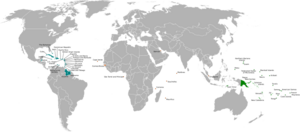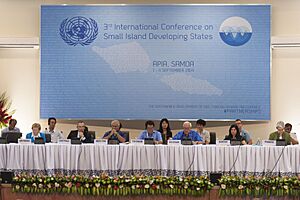Small Island Developing States facts for kids
Small Island Developing States (SIDS) are special countries that are often small islands or coastal areas. They are usually low-lying, meaning they are not very high above sea level. These countries face similar challenges because of their small size.
Some of these challenges include having small but growing populations. They also have limited natural resources, like fresh water or land for farming. Another problem is that they are often far away from other larger countries. This can make trade and travel difficult.
SIDS were first recognized as a special group of developing countries in 1992. This happened at a big meeting called the United Nations Conference on Environment and Development. In 1994, a plan called the Barbados Programme of Action was created. This plan was made to help SIDS grow and develop in a sustainable way.
Where are Small Island Developing States Located?
The United Nations lists 52 Small Island Developing States. These countries are grouped into three main areas around the world:
- The Caribbean Sea
- The Pacific Ocean
- The Africa, Indian Ocean, Mediterranean Sea and South China Sea (AIMS) region
Each of these regions has its own group that helps the countries work together. For example, the Caribbean Community helps countries in the Caribbean. The Pacific Islands Forum helps countries in the Pacific. The Indian Ocean Commission helps countries in the AIMS region.
List of SIDS Countries
Here is a list of the Small Island Developing States, grouped by their region:
See also
 In Spanish: Pequeños estados insulares en desarrollo para niños
In Spanish: Pequeños estados insulares en desarrollo para niños



